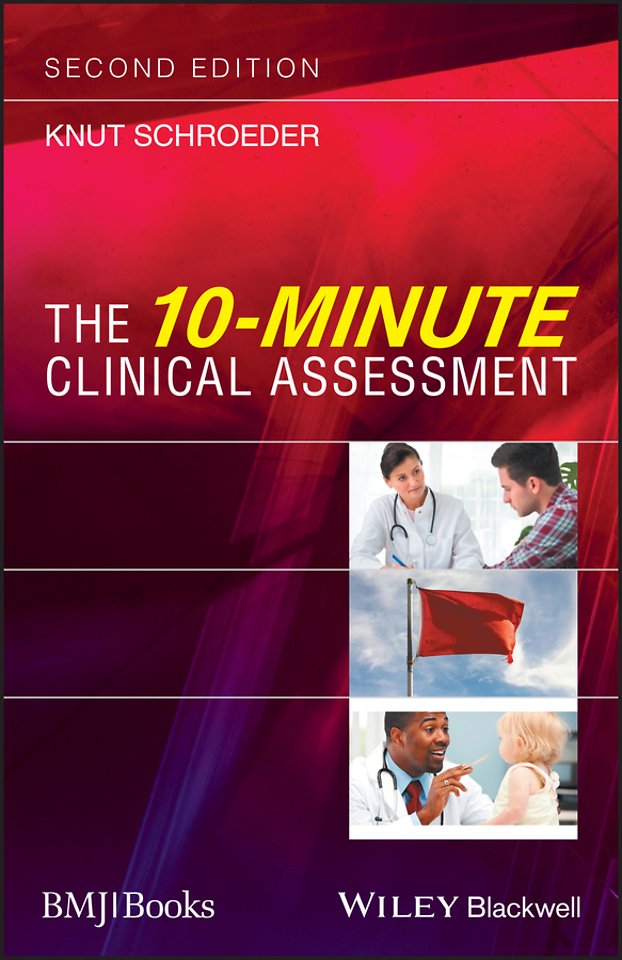The 10–Minute Clinical Assessment 2e
Samenvatting
Clinical assessment is at the heart of medicine. Health professionals working in busy clinical settings, such as general practitioners, nurse practitioners and hospital doctors on–call, often have to assess patients under considerable time constraints. This book teaches the reader how to gather clinical information effectively, accurately and safely even when time is at a premium.
Provides a systematic method of collecting and assessing relevant clinical information by suggesting step–by–step examination routines, including important patient–centred questions
Focuses on common symptoms and presentations
Treatment reflects the latest in evidence based practice (including latest NICE Guidelines)
Specifically covers the clinical skills assessment (CSA) part of the Membership of the Royal College of General Practitioners (RCGP) examination
Written by an experienced medical educator and practicing GP, in consultation with a multidisciplinary team of medical students, GPs, PG trainees, hospital doctors and nurses
Specificaties
Inhoudsopgave
<p>Preface to 1st edition, xii</p>
<p>Preface to 2nd edition, xiv</p>
<p>About the author, xv</p>
<p>Acknowledgements, xvi</p>
<p>Selected useful resources, xvii</p>
<p>The focused consultation, 1</p>
<p>Focused clinical assessment, 3</p>
<p>Useful consultation tools, 8</p>
<p>Red flags in general practice, 12</p>
<p>Undifferentiated and miscellaneous presentations, 15</p>
<p>Suspected cancer, 17</p>
<p>Weight loss, 24</p>
<p>Tiredness, 29</p>
<p>Dizziness, 35</p>
<p>Chronic pain, 41</p>
<p>Sudden collapse and syncope, 45</p>
<p>Frequent attenders, 50</p>
<p>Medication review and polypharmacy, 54</p>
<p>Medically unexplained symptoms, 58</p>
<p>Insomnia, 63</p>
<p>Irritability and stress , 67</p>
<p>Domestic violence, 71</p>
<p>Homelessness, 75</p>
<p>Paediatrics and adolescent health, 81</p>
<p>The sick and/or feverish child, 83</p>
<p>Suspected meningococcal meningitis and septicaemia, 90</p>
<p>Neonatal jaundice, 95</p>
<p>Faltering growth, 99</p>
<p>Headache and migraine in children, 104</p>
<p>Head injury in children, 108</p>
<p>Suspected cancer in children and adolescents, 113</p>
<p>Abdominal pain in children, 118</p>
<p>Hearing loss in children, 124</p>
<p>Childhood cough, 128</p>
<p>Childhood wheeze, 133</p>
<p>Constipation in children, 138</p>
<p>Childhood obesity, 142</p>
<p>Suspected child abuse and neglect, 148</p>
<p>Nocturnal enuresis, 153</p>
<p>Knee problems in children, 158</p>
<p>Hip problems in children, 163</p>
<p>Adolescent health problems, 167</p>
<p>Self–harm in teenagers, 171</p>
<p>Eating disorders, 175</p>
<p>Autism–spectrum disorder, 180</p>
<p>Cardiovascular, 183</p>
<p>Chest pain, 185</p>
<p>Palpitations, 191</p>
<p>Cardiovascular risk assessment, 195</p>
<p>Hypertension, 200</p>
<p>Atrial fibrillation, 205</p>
<p>Heart failure, 209</p>
<p>Peripheral vascular disease, 215</p>
<p>Respiratory, 221</p>
<p>Shortness of breath, 223</p>
<p>Haemoptysis, 228</p>
<p>Suspected lung cancer, 233</p>
<p>Asthma, 237</p>
<p>Chronic obstructive pulmonary disease, 242</p>
<p>Suspected pneumonia, 248</p>
<p>Pleural effusion, 252</p>
<p>Pulmonary embolism, 256</p>
<p>Endocrine and metabolic, 261</p>
<p>Diabetes review, 263</p>
<p>Obesity, 268</p>
<p>Hirsutism in women, 273</p>
<p>Hypothyroidism, 277</p>
<p>Hyperthyroidism, 281</p>
<p>Hyponatraemia, 285</p>
<p>Hypernatraemia, 289</p>
<p>Hypokalaemia, 292</p>
<p>Hyperkalaemia, 296</p>
<p>Hypocalcaemia, 299</p>
<p>Hypercalcaemia, 302</p>
<p>Gastrointestinal, 307</p>
<p>Nausea and vomiting, 309</p>
<p>Dysphagia, 313</p>
<p>Dyspepsia and reflux, 317</p>
<p>Upper gastrointestinal bleeding and melaena, 321</p>
<p>Abdominal pain, 326</p>
<p>Constipation, 332</p>
<p>Diarrhoea, 336</p>
<p>Rectal bleeding and suspected bowel cancer, 341</p>
<p>Abnormal liver function tests, 346</p>
<p>Irritable bowel syndrome, 351</p>
<p>Inflammatory bowel disease, 356</p>
<p>Coeliac disease, 361</p>
<p>Infectious diseases, 365</p>
<p>Fever of unknown origin, 367</p>
<p>Fever and illness in the returning traveller, 372</p>
<p>HIV infection and AIDS, 377</p>
<p>Tuberculosis, 383</p>
<p>Rheumatic fever, 388</p>
<p>Haematology, 393</p>
<p>Iron–deficiency anaemia, 395</p>
<p>Macrocytic anaemia (B12 and folate deficiency), 400</p>
<p>Bleeding disorders, 405</p>
<p>Myeloma, 409</p>
<p>Musculoskeletal, 413</p>
<p>Soft–tissue injury, 415</p>
<p>Acute hot and swollen joint, 420</p>
<p>Chronic musculoskeletal pain, 424</p>
<p>Polyarthralgia, 429</p>
<p>Neck pain, 435</p>
<p>Back pain, 440</p>
<p>Shoulder and arm problems, 446</p>
<p>Elbow problems, 452</p>
<p>Hand problems, 456</p>
<p>Hip pain, 461</p>
<p>Groin problems, 466</p>
<p>Leg pain and/or swelling, 470</p>
<p>Knee pain, 476</p>
<p>Foot and ankle problems, 483</p>
<p>Gout, 489</p>
<p>Osteoporosis, 493</p>
<p>Neurology, 499</p>
<p>Headache, 501</p>
<p>Transient ischaemic attack and stroke, 508</p>
<p>Head injury in adults, 514</p>
<p>Suspected or confirmed brain tumour, 519</p>
<p>Tremor, 524</p>
<p>Motor neurone disease, 528</p>
<p>Peripheral neuropathy, 533</p>
<p>Multiple sclerosis, 538</p>
<p>Gynaecology, 543</p>
<p>Combined oral contraception, 545</p>
<p>Menorrhagia, 549</p>
<p>Amenorrhoea, 553</p>
<p>Breast lumps, 557</p>
<p>Loss of libido, 561</p>
<p>Polycystic ovary syndrome, 565</p>
<p>Suspected ovarian cancer, 570</p>
<p>Obstetrics, 575</p>
<p>Routine antenatal care, 577</p>
<p>Bleeding in early pregnancy, 582</p>
<p>Abdominal pain in pregnancy, 586</p>
<p>Pre–eclampsia, 591</p>
<p>Urology and renal medicine, 595</p>
<p>Suspected urinary tract infection in women, 597</p>
<p>Lower urinary tract symptoms in men, 601</p>
<p>Urinary incontinence, 606</p>
<p>Urethral discharge in men, 612</p>
<p>Scrotal and testicular problems, 616</p>
<p>Erectile dysfunction, 621</p>
<p>Renal or ureteric colic (kidney stones), 626</p>
<p>Haematuria, 631</p>
<p>Chronic kidney disease, 635</p>
<p>Mental health, 641</p>
<p>Depression, 643</p>
<p>Self–harm and harm to others, 648</p>
<p>Anxiety, phobias and panic disorder, 653</p>
<p>Alcohol screening, 657</p>
<p>Alcohol dependence, 662</p>
<p>Illicit drug misuse, 667</p>
<p>Obsessive compulsive disorder, 672</p>
<p>Mania, 675</p>
<p>Schizophrenia, 679</p>
<p>Skin, 685</p>
<p>Moles and malignant melanoma, 687</p>
<p>Pressure ulcers, 690</p>
<p>Ophthalmology, 695</p>
<p>Eye injuries, 697</p>
<p>The acute red eye, 701</p>
<p>Gradual painless visual disturbance, 706</p>
<p>Sudden painless visual disturbance, 710</p>
<p>Eye problems in older people, 715</p>
<p>Ear, nose and throat, 719</p>
<p>Neck swelling, 721</p>
<p>Sore throat, 725</p>
<p>Ear pain, 730</p>
<p>Hearing loss in adults, 734</p>
<p>Tinnitus, 738</p>
<p>Sinusitis and facial pain, 742</p>
<p>Problems in older people, 747</p>
<p>General health assessment in older people, 749</p>
<p>Cognitive problems and dementia, 755</p>
<p>Falls in older people, 760</p>
<p>Delirium and acute confusional state, 766</p>
<p>Depression in older people, 772</p>
<p>Palliative and end–of–life care, 777</p>
<p>Parkinson s disease, 781</p>
<p>Index, 785</p>

